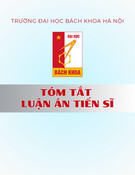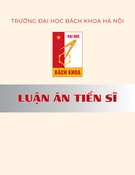
MODELLING AND EXPERIMENTAL INVESTIGATIONS OF A BI-MODAL
UNMANNED UNDERWATER/AIR SYSTEM
A thesis submitted in fulfilment of the requirements for the degree of Master of Engineering
Dian GUO
Bachelor of Engineering, Shenyang Aerospace University
School of Engineering
College of Science, Engineering and Health
RMIT University
April 2019


Modelling and Experimental Investigations of a Bi-Modal Unmanned Underwater/Air System i
Declaration
I certify that except where due acknowledgement has been made, the work is that of the
author alone; the work has not been submitted previously, in whole or in part, to qualify for any
other academic award; the content of the thesis is the result of work, which has been carried out
since the official commencement date of the approved research program; any editorial work,
paid or unpaid, carried out by a third party is acknowledged; and ethics procedures and
guidelines have been followed.
Signature: Dian Guo
Date: 29 March 2019

ii Modelling and Experimental Investigations of a Bi-Modal Unmanned Underwater/Air System
Acknowledgements
I would like to express my great appreciation to Prof. Pier Marzocca for his valuable and
constructive guidance during this research work throughout two years. He is my best role model
for his enthusiasm and hard work towards research work.
I must express my gratitude to Prof. Cees Bil for his continued support and precious
advice. I am very grateful to his knowledge and many insightful discussion and suggestions on
this project. His approach, vision and guidance in research enabled me to learn a lot.
I am extremely lucky to have Prof. Pier Marzocca and Prof. Cees Bil as my supervisor
who care so much on my work and respond my questions and queries so promptly. It is very
enjoyable to be the student of those two professors, and it is a fantastic research journey.
Thanks for the RMIT University for the Translational Research Seed Grant to provide
financial support for this project.
I would also appreciate the help from RMIT workshop and all the staffs. This vehicle
cannot be there without the help from them. Thanks for the nicest guy Paul Muscat of the
composite lab helping me in every situation. It is a pleasure to work with him. Thanks to the
technician Michael Delaney and Michael Scherf for the mechanical section, Eli for the
computer numerical control (CNC) machine. Also, a lot of thanks given to Gil Atkin and Greg
Osward for the suggestion and help for the wind tunnel test and experiment arrangement and
thanks to James for the propulsion system test. In addition, I will never forget our Santa Claus
Patrick. Especially thanks to the Dr. Matthew Marino and the UAS team for providing the
resources and help for the propulsion system test. Also, thanks to Junrong Ye and Mark
Simpson for the contribution on this project.
I also thank my friends for providing support and friendship that I need. Thanks to my
research mate Antonio, I can’t forget the time that we work together and create great
achievement. A lot of thanks to Federico, my gym coach, sansei, and desk mate. The guy who
worked with me till late and share so many good memories. Also, thanks to my best roommate
Loyld, my little spoon Tito, Afanti Reza, my buddy Eli, Buddha Arpen, Organiser Anne,
Second Fede, Nichacorn, my sunshine Enrico, Joyce, Alessia, who limited my homeless and
gave me all best memories in the last two years. Thanks to my senior Chen Dongyang, Li yufei
and Prof. Han for the guidance on the research. Special thanks to my mate Liu Da in China.

Modelling and Experimental Investigations of a Bi-Modal Unmanned Underwater/Air System iii
Thanks for your technical and emotional support. I am the groomsman always ready for you.
Also, thanks to my friends Hou Liguo, Hong Tu for the long time international calls and
meditation from far away. Thanks to Jennifer, Frida, Amber, and all the friends from city, who
opened my world to art and it is always good time spent with you guys. I would like to express
my special thanks to my best friend, beloved Julia. There is a love can’t be conveyed by words.
Thank you for the unconditional support during my research, life and every beautiful time
shared with the beautiful you. At last, but not least, I would like to convey a lot of thanks to my
family, and my parents, the best parents in this world, thanks for the courage to support me
study overseas and always stand by my side no matter when I hold the trophies or went through
the tough time.
The life is a book where you write your tales on. My colourful book is because every one
of you.





![Luận văn Thạc sĩ: Tổng hợp và đánh giá hoạt tính chống ung thư của hợp phần lai tetrahydro-beta-carboline và imidazo[1,5-a]pyridine](https://cdn.tailieu.vn/images/document/thumbnail/2025/20250816/vijiraiya/135x160/26811755333398.jpg)




















